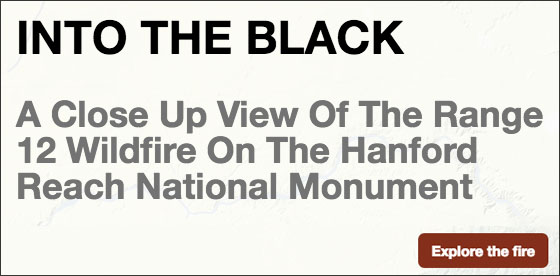In southeast Washington, the Range 12 Fire is finally out. But now there’s 176,600 acres of black. And it’s roasted much of the valuable habitat on the Hanford Reach National Monument.
See the landscape that was burned in the Range 12 fire
Usually, it’s beautiful here. It’s long been a tightly protected swath of land. First, an enforced security buffer around the Hanford nuclear site. In 2000, it was set aside as a protected federal monument. That’s kept it from grazing, the plow and development.
Within its bounds: Rattlesnake mountain, and the last undammed stretch of the Columbia River. It’s been home to hundreds of elk and dwindling species like sage-grouse and burrowing owls.
Now a lot of that’s gone.
‘I’ve cried before, and I’ll probably cry again’
Heidi Newsome is a federal wildlife biologist. And she’s closely managed this dramatic desert landscape for nearly two decades.
But now, this place she loves for its beauty and solitude -- feels greatly disturbed, eerie.
Everything’s gone at the Reach, shadowed with black ash.
“It was a little frustrating, and I’m upset,” Newsome said.
Newsome is the one who’s developing a plan to restore as much of this habitat as funding allows.
“I’ve cried before, and I’ll probably cry again after I get over the shock of what’s happened,” Newsome said.
A burned oasis
You can smell the char at a burnt-up desert oasis called Rattlesnake Springs. We have to hike there.
“Smells like ash and dust,” Newsome said.
Get a close-up view of the Range 12 Wildfire aftermath
It’s a huge canyon, kind of like a grotto. And there are beautiful trees -- mostly Pacific Willows and some black cottonwoods.
This once-lush place is all fed by an ancient underground spring. A few of the spring’s trees have managed to escape the fire. But a large chunk of this oasis isn’t suited for flocks of migrating birds anymore.
Back in the truck and further along, Newsome negotiates deeply rutted sandy roads and the ash. Usually there are sagebrush, bunchgrass and desert crust here. Now there’s nothing holding the talcum-like topsoil.
Newsome said dust storms are already popping up and there will be running mud later on when the rain and snow hit.
No time to recover
Still, some are benefiting from all this destruction -- for now. A half-eaten dead snake tells the tale. Snakes, small mammals and lizards have little cover from raptors like hawks and owls.
“They will have a lot of prey for a short time,” Newsome said. “Then it’s gonna be very little prey for a long, long time until this all recovers.”
See plants that burned and some that survived
Recovery time--that’s the problem. Newsome said fire is coming too often. It should be every 50 to 80 years -- not every 5 to 10. The slow-growing desert species just can’t recover.
“It's just one of those things I guess,” Newsome said. “You just pick yourself up again and go on, you know.”
For her that means planting trees, protecting them from elk with tall fences and planting pencil-high sagebrush.
Two previous fires left her with 50,000 acres to restore. On this burn, she’s hoping for money enough to deal with about 10 percent of what’s been blackened.



